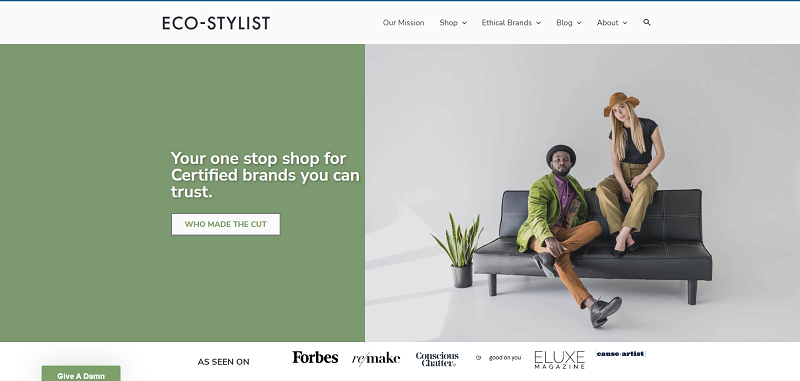
A former psychology major, Reyna Martinez was looking for a new career path where she could blend her interests in understanding what motivates people while also doing creative work. She had been creating digital art since middle school–saving up her babysitting money to buy copies of Photoshop and Lightroom software so she could experiment.
Before studying UX design, Reyna worked in academia as a student advisor, hosting resume building workshops and advising students one-on-one for job and internship assistance.
Her favorite part of the Springboard experience was the Industry Design Project–a four-week internship with a real-world client which all students enrolled in the UI/UX Design Career Track are required to complete. Reyna was placed with a fashion brand called Eco-Stylist. She redesigned their website to grow organic traffic and lower bounce rates.
“Having real-life experience not only helped from a technical standpoint, but it gave me something to talk about during job interviews,” she said.
Now, she’s a few weeks into her new job as an associate UX designer at ServiceMax, an IT consulting company headquartered in Pleasanton, CA.
I knew I wanted to work with people–and, for lack of a better term, make a difference–so I majored in psychology at Biola University. After college, I worked in client-facing roles including academic advising and recruiting. I loved talking to people, hearing their stories, and helping them find the right career path. Like a lot of other people, I decided in 2020 that I wanted a career change.
I've always been a creative individual, I’ve always loved making digital art. Also, psychology comes with a big research component–you're doing a lot of interviews and creating outcomes based on research. I think UX design is a great blend between psychology, being creative, and finding solutions that work for people. That’s what led me to it.
To be completely candid, while I loved my previous job, I asked myself, "Would I be happy doing this 10 years from now? Would I regret not going into a creative industry?" In a sense, UX design is a creative industry because you get to build things. I found my answer and I said, "You know what, I don't want to regret anything. I want to jump into this."
I started creating digital art before I was in middle school. I was 12 or 13, and that was when programs like Photoshop and Lightroom began to emerge. I remember buying these software programs at Best Buy using my babysitting money. I created illustrations and color partners. That was my first exposure to typography and design principles. That's when my design story really started.
I just started, but it has been very exciting. I work with an amazing team and we are all so collaborative and focused on solving the problem at hand. My day-to-day consists of design meetings with our clients and doing user research. I work a lot on Figma to design different elements for our projects.
I found Springboard by researching different bootcamps. I watched a lot of YouTube videos to hear about other people’s experiences with Springboard. What stood out to me the most about Springboard was the one-on-one mentorship with industry professionals. I was also really inspired by the student success stories.
My mentor was Ciarda Henderson-Geist [senior director of product design at Gartner]. I called her Dr. Henderson, because she has a Ph.D. She had a lot of UX experience–she's been in the industry for over 10 years. I thought it was really cool that Springboard provided mentors with such vast experience in design. She was very kind and gentle in her approach and she was a great coach, which worked for me.
She's very intentional when she speaks, so when she told me that I was one of her top students, that meant a lot to me. She built a lot of confidence in me throughout my Springboard experience–and I think that's just a testimony to how Springboard selects their mentors.
For me, the IDP was the best part about Springboard. I worked with a company called Eco-Stylist, where I collaborated with a small group of designers. My experience with the IDP prepared me to work in UX design because I learned to collaborate with other designers. I also loved knowing that we were helping a small business.

A lot of UX professionals struggle with imposter syndrome–even those who have been in the industry for over five years tell me that they still struggle with it. But I think the UX community is so supportive; we’re like this big family of industry professionals who back each other up and reassure you that you belong here.
Oh, yeah. Just knowing that I could consult with my fellow students on Slack was really helpful. I’ve become friends with some of the people that I met on the Slack channel, and it's awesome to see them landing new design jobs. You feel this sense of camaraderie with the people who are on this journey with you. Even though we were remote, that did not hinder the opportunity to create a sense of community.
To be completely candid, the job search was rough. I live in the Bay Area and the job market is so different out here. For the first six months of my job search, I did not get any interviews at all, and I felt discouraged for a while. But another great thing about Springboard is that I wasn't alone. I had my career coach and she would challenge me and give me advice.
The job search process for me was a lot like the design process. You figure out what isn’t working and then you create a solution. With my career coach’s help, I updated my resume and portfolio. She pushed me to do information interviews with senior designers at big companies. Once I started changing my job search strategy, that's when I started landing interviews.





